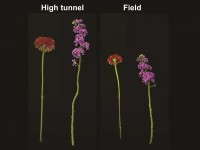Do High Tunnels Make The Cut?

Increased consumer interest in farmers’ markets, buying local and sustainability make this an opportune time for domestic specialty cut flower growers. Local market advantages of specialty cut flowers exist, including product freshness, quality and availability of stems that do not ship well or are difficult to find.
Currently, an estimated 73 percent of cut flowers sold in the U.S. are imported. However, the number of domestically grown specialty cut flower stems sold has increased from 81 percent of total U.S. cut flowers produced in 2005 to 92 percent in 2010.
To compare high tunnel and field production of specialty cuts, one must consider flower quality and yield. Plant size and architecture are quality parameters of these crops, and they can be controlled culturally (i.e. fertility and growth regulators) and environmentally (i.e. temperature and light).
Flower size, number of flower buds, time to flower and stem length and strength can influence the quality, marketability and yield of cut flowers.
Although they don’t offer full control over environmental parameters, high-tunnels offer an option for specialty cut flower growers to overcome the high costs of greenhouse construction and production.
High Tunnels Grow Better Flowers
Cut flower yield per square foot was never higher for any of the cultivars tested in the field compared to the high tunnel. In fact, we harvested 23, 13, 172, and 178 more marketable Antirrhinum ‘Potomac,’ celosia, dianthus and zinnia stems from the high tunnel per 10 square feet respectively. Stems harvested from the high tunnel were significantly longer for Antirrhinum ‘Potomac’ and Antirrhinum ‘Rocket’, lisianthus, stock and zinnia. In terms of stem caliper, stock and zinnia were thicker. In this study, we used 12 inches as the minimum stem length for a stem to be considered marketable. Stock and zinnia stems had significantly larger stem caliper when grown in the high tunnel than the field, along with longer stem length. The combination of longer stem length and larger stem caliper for these two cultivars makes high tunnel production an advantage over field production when growing high-quality stems. On the other hand, although Antirrhinum ‘Potomac’ stems were longer when grown in the high tunnel, they consequently had smaller stem caliper. This combination led to problems supporting the stems in the high tunnel. The stems were too heavy and weak to be successfully supported by the mesh system we provided.
Cultivars Matter In High Tunnels
The results obtained from this study suggest that high tunnel production does offer several benefits over field production when growing high-quality specialty cut flowers. However, the specific benefits associated with high tunnel production are cultivar-specific. Seven of the cultivars selected for the study produced higher quality stems in the high tunnel compared with the field. For example, stems of Antirrhinum ‘Rocket’ grown in the high tunnel were longer with longer inflorescences than stems grown in the field, making them higher quality.
For Dianthus ‘Amazon Neon,’ high-tunnel production yielded more stems per square foot and reduced time to harvest, but flowers that were slightly smaller. Lisianthus ‘Mariachi’ stems harvested from the high tunnel were longer with larger flowers than stems harvested from the field, and therefore were higher quality. Helianthus ‘Sunrich Yellow’ stems produced in the high tunnel had notably larger flowers with less visible insect damage than stems grown in the field. Premier sunflower performed well in both field and high-tunnel environments, but time to harvest in the high tunnel was reduced. Zinnia ‘Benary Giant’ and Matthiola ‘Katz’ stock stems were higher quality in the high tunnel because they were longer with longer inflorescences and had larger stem caliper and flowers than stems from the field. In addition, more stems were harvested per square foot from the high tunnel than from the field, making zinnia a good choice for high tunnel production in the Midwest.










